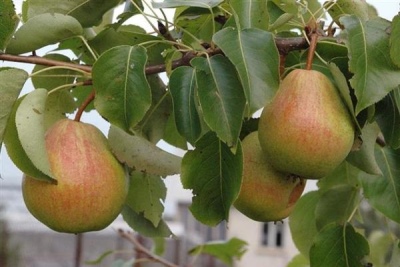
- Authors: A. M. Lukashov, Khabarovsk (FGBUN "KhFITS FEB RAS")
- Appeared when crossing: Finnish yellow x Ussuri pear
- Name synonyms: Tyoma, Tyoma
- Year of approval: 1947
- Fruit weight, g: 90-100, sometimes more
- Ripening terms: early autumn
- Fruit picking time: end of August
- Appointment: technical
- Growth type: vigorous
- Yield: high
Even very old plants in the right hands bring good results. This fully applies to pear Tema. However, even such a solid reputation, gained over the decades, does not mean that one can dismiss the study of the peculiarities of culture.
Breeding history
The pear variety Tema was included in the State Register back in 1947. The plant was created in the Far East. To obtain a culture, the Finnish yellow was crossed with the Ussuri Pear.
Description of the variety
The plant has official synonyms - Tyoma and Tyoma. Basically, it has a purely technical purpose. Tema trees grow vigorously, they can grow up to 340-370 cm. Other features:
the crown resembles a wide pyramid in shape;
the density of this crown is moderately high, spreading is often noted;
straight shoots are well developed;
skeletal branches can be retracted from the trunk at sharp angles;
the white flowers are medium-sized, have long pedicels and are slightly pubescent.
Fruit characteristics
Tema's fruits weigh from 90 to 100 g. In some cases, they can reach 300 g. Light yellow color dominates on the surface of the pear. At the same time, an orange-red integumentary color, complemented by dull strokes, is necessarily also noted. The cover color itself cannot boast of special brightness.
Taste qualities
Pear pulp The theme is dense. It also differs in addition to pleasant juiciness. Loose in consistency, the fruit is usually sour. A tart note is added to the main taste. Despite such a variety, the ensemble of tastes is estimated to be mediocre, but there is a great powerful aroma.
Ripening and fruiting
Pear The theme belongs to the early autumn group. It is necessary to harvest the fruits at the end of August. It is believed that consumer ripeness is normally reached in the first decade of autumn. After vaccination, the collection begins at 3-4 years. You can count on mass fruiting from the age of 6-8, and then it will go annually.

Yield
Thema's ability to produce 84 kg of fruit is declared. When cultivated by plantation order, the harvest can reach from 120 to 260 centners per 1 hectare. Such a significant spread visually confirms the importance of meteorological conditions and practical agricultural technology. The share of marketable fruits can reach 90%. The share of the first grade sometimes accounts for 50%.
Growing regions
You can plant the theme pear in Western Siberia. The variety is also zoned in the Far East. This plant can theoretically be grown in more favorable regions of Russia. However, agricultural technology has not been developed, and such attempts are made at your own peril and risk.
Landing
In the main pear growing regions, Tema can be grown in almost any soil. However, it is recommended to choose the highest areas where the risk of freezing is minimized.Planting dates are the same as for other pears.


Growing and care
Ripeness is usually reached in early September. You need to collect ripe pears as quickly as possible, because otherwise they will crumble. In order for Thema trees to develop normally, they will have to be sprayed. Removing diseased and broken branches is another prerequisite for success. The danger for this variety is primarily represented by insects such as the moth and moth.
Variety Tema is not self-pollinated. The best pollinating pears are:
Palmyra;
Olga;
Fields.
There are no significant differences from other pear trees in agricultural technology. For pear pears, diligent regular watering is very important. The intensity of irrigation is selected taking into account the age of the plant and the characteristics of the climate, the actual weather. The variety is frost-hardy, but still sometimes it is necessary to protect the plantings from the harsh winter. It is useful to cover the trunk with snow, especially in years with little snow.




Like any other fruit trees, the pear needs protection from various diseases and pests. When planting a pear on your site, you need to know in advance what diseases you should beware of. To successfully carry out the struggle, it is necessary first to correctly identify the cause of the problem. It is important to distinguish signs of disease from manifestations of the presence of insects, mites, caterpillars and other types of pests.





































































